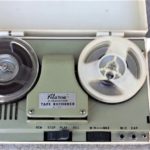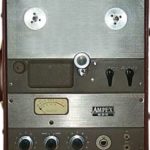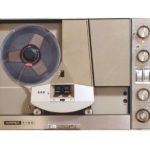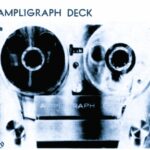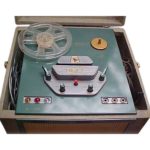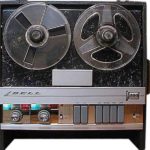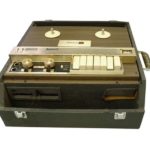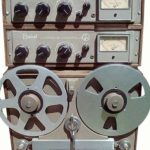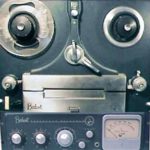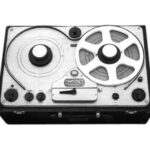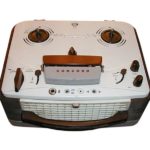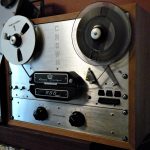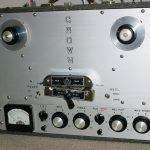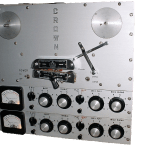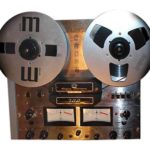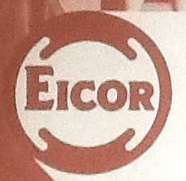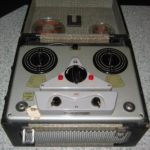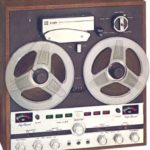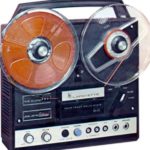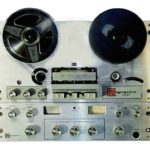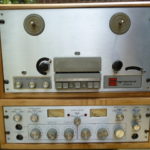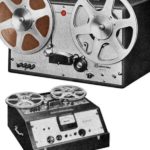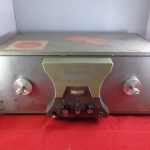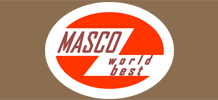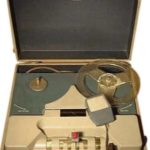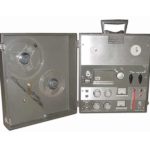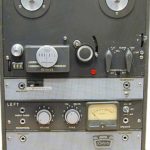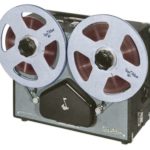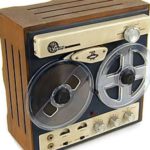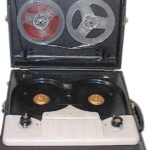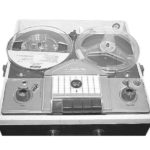In order to use this feature, you need register and become a member.
Already a member? Login Register hereReel to Reel Tape Recorders From The USA
- Alaron
- Allied
- Ampex
- Ampligraph
- Arvin
- Astrocom
- Bell
- Bell & Howell
- Berlant
- Brush
- Concertone (Berlant/Teac)
- Concord
- Crescent
- Crestwood
- Crown
- Daystrom
- Eico
- Eicor
- Ekotape
- Emerson
- Ferguson Electronics
- FME
- Freeman
- Knight
- Lafayette
- Magnecord
- Marantz
- Masco
- MCI
- Newcomb
- Nortronics
- Pentron
- Presto
- RCA
- Realistic (Radio Shack)
- Recordio
- Revere
- Roberts
- Scully
- Silvertone
- Stancil-Hoffman
- Stephens Electronics
- Tapak
- Tape-Athon
- Tapesonic
- V-M Voice Of Music
- Vernon
- Viking
- Webcor
- Wilcox-Gay
- Wollensak

Alaron of Auburn Hills Michigan seems to have made primarily portable Reel to Reel machines that were made in Japan, likely to their specifications. The following models have been found 421 3″ portable HR-407 3″ portable HR-408A 3″ portable B-506 7″ home recorder

1944 To 1995
1944– Founded in San Carlos CA. by Alexander M. Poniatoff. The name AMPEX stands for Alexander M. Poniatoff Excellence. 1948– Model 200A First Ampex Tape Recorder Early 1950s– Ampex produces 1 and 2 track machines using ?1/4-inch tape. Model 400 affordable professional quality audio recorder. 1952– Produces a Hi-Fi movie sound system using sound magnetically recorded on 35mm film, first used in movies The Robe (1953) and Oklahoma (1955) (35mm & 70mm) 1953– April, Model 350 replaces Model 400 1954– Unknown Truck Driver, Elvis Presley records first single, “That’s All Right” at Sun Studios in Memphis using Ampex reel-to-reel 1957– Read More

1959 To 1962
Ampligraph appears to be very short-lived US tape recorder manufacturer that we found in a buyers guide. As compared to so many lower-priced tape recorders in 1961, the Ampligraph 66 at $335, looked to be worthy of investigation. Very little information is available, however this article, also from 1961, gave us a clue, that something half decent was produced. Who knows if they got many out the door.

Arvin, was a brand of Noblitt-Sparks Industries

1961 To Present
Astrocom of Oneonta NY, was founded in 1961 by Derwood Lifgren and specializes in electronic design and manufacturing for space programs, the military, municipal police departments, and industry and has worldwide distribution. They made a brief foray into tape recorders in the late’s 60s and early 70s and also produced a quadraphonic cassette deck. The company is still in business here in 2022.
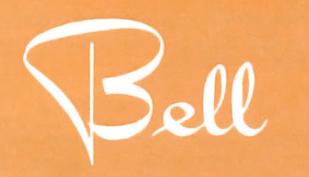
1933 To
1930’s Bell Sound Systems was founded by Floyd W. Bell in Columbus, Ohio. Bell Sound Systems manufactured hi-fi components, and developed the first commercially available reel-to-reel tape recorder 1940’s Bell manufactured public address systems, hi-fidelity amplifiers, tuners, and magnetic tape recorders 1950’s The company reached its peak with its space-age hi-fi and stereophonic components. 1953 Bell Sound was acquired by Thompson Products. Bell became a wholly owned subsidiary of Thompson Products (TP). Bell introduced the Bell 3D Bin-aural amplifier in, the first commercially available stereo amplifier for home hi-fi use. 1957 Bell Sound released new amplifier and tuner models housed Read More

1946 To 1970
1946– Emmanuel “Bert” Berlant (1911-1985) started Berlant Associates Inc, producing hi-fidelity audio equipment 1948– Berlant developed the magnetic transducer head for recording audio on magnetic tape. Berlant’s professional grade products were used by recording studios and radio stations 1949– Berlant started manufacture of dictating machines using the new magnetic tape recording technology 1950– Berlant introduces three Concertone models,the basic 1401, without a frame, the 501 a portable suitcase model and the 702, a professional grade recorder with console cabinet 1954– Berlant Concertone 20/20 Series 30 introduced. This was an early vertical reel to reel model marketed to radio stations for Read More

1960 To
1960’s Concord Electronics Corp., the American re-seller of Japanese made consumer electronics, was founded 1961 Introduced the Model 103 open-reel tape recorder 1962 Released the model AF-40 AM-FM receiver with stereo amplifier. 1965 Released the model 4444 open-reel stereo tape recorder 1967 Concord released the model 501 D tape deck 1970 Released the model 776 stereo automatic reverse reel to reel recorder, and the model 300 tape recorder with “Reverse-A-Track” 1975 Released the model 330 transistorized tape recorder 1980 Introduced the F-101 cassette recorder

1947 To Present
Crown Reel to Reel History Clarence C. Moore (1904-1979) Built his first audio amplifier when he was a senior in high school. Known across the community as Loud Sound Clarence, he was a man with broad interests and knowledge, who earned a degree in math, music and english. He became a pastor and schoolteacher in Michigan. In the 1930’s, Clarence heard about a missionary organization in Ecuador that was having problems with their transmitter as a result of wild voltage swings. He had already solved similar problems on his farm where there was no electricity, having hooked up a generator Read More
Daystrom
The Daystrom Electric Corp. of Poughkeepsie NY made Crestwood branded tape Recorders in the 1950’s. In 1954 they purchased the Heath company which was already building electronics in kit form. Daystrom was bought by Schlumberger Limited in 1962. The company would continue to market Heathkit until 1992.

We don’t know much about this company. This photograph was originally from Sun roundup records dated July 28, 1963 and the photograph was taken by Bill peters from the Denver Post. Pictured are Charles Satter the Freeman distributor, Jim Gray sales rep and Eugene J Freeman of Freeman Electronics Corp. admiring the all new all transistor Freeman 200 tape recorder.


1946 To 1995
1946– Magnecord, Inc. was founded in Chicago by 4 men who worked for the Research Division of The Illinois Institute of Technology, R.L.Landon, John S. Boyers, R.J. Tinkham and C.G. Barker. 1947– Magnecord’s first product was the professional wire recorder SD-1 (Super Duper). The company moved to produce reel tape recorders beginning with the PT series. 1948– The Magnecord PT6 was one of the very first broadcast-quality tape recorders ever made 1952– Magnecorder PT6J-AH and Magnecorder PT6-J released 1953– According to a January 1953 article in Magnecord Inc, the company has been working on binaural (stereo) technology for two years. Read More

1965 To 1982
1959 – Grover ‘Jeep’ Harned starts custom building mixing consoles and preamplifiers for Criteria Recording Studios and later starts a retail store, Music Center Inc. 1965 – Music Center Incorporated is founded 1968 – JH-5 tape recorder is introduced 1970 – JH-10 MCI’s first tape transport with 16 tracks is produced 1971 – JH-16 MCI’s first mass-produced series of tape recorder (1971-1979) – MCI’s First 1/4″ transport introduced 1972 – Introduces JH-400 the world’s first commercial in-line mixing console (1972-1977) – MCI tape AutoLocator (JH-45) similar to a remote control and could store a number of presets recalling particular positions Read More

1937 To 1967
Founded by Robert Newcombe 1937, Newcombe audio product company produced FM tuners and amplifiers in the 1950s and their first tape recorder in 1958, the SM-310. They were originally located in Glendale CA and relocated to Hollywood. This company appears to have been inspired by the magnecord machines of the day, with quite a few similarities.

Nortronics, a significant tape head manufacturer, may have produced tape recorders for testing purposes. Only speculation at this point. The example below is just a transport with no Preamplifier electronics. Any further information about tape recorders associated with this company would be appreciated.

1915 To 1965
The Presto Products Company was founded in 1915 and would later be renamed Presto Recording Company in 1932.

The Wilcox Gay Corporation of Charlotte Michigan branded some of their early tape recorders Recordio.

1919 To
1919– Scully Recording Instruments founded by John J. Scully & his son Larry Scully in Connecticut, manufacturing cutting lathes used to make records. Almost all major masters were cut on a Scully Lathe until the 1960’s 1960’s– When Neumann lathes arrived in North America, Scully decided to move into the tape recorder market. Scully releases the 270 and 280 models. 1966– As recording studios were starting to move towards to 8-tracks on 1″ Tape, Scully positioned themselves to gain this market 1967– Scully was purchased by Dictaphone, but production was kept the same. Scully introduced the 1″ 12-track; 284 transport, Read More

Stephens Electronics, Inc. after an auspicious start in eight track tape recorders, John Stephens began around 1970, producing excellent studio tape recorders. He pioneered a unique tape drive system that did not use controllers or a capstan motor. Just the supply and take-up motors were required as he had a unique rotating idler that compared the output of an LED and pulses that were compared to a crystal-locked time base for servo transport motor control. The Stephens machines were all half track with tape widths between half-inch and 2 inch. It is estimated that about 200 or so were manufactured. Read More
Tapak
What may have been a Short business run and known as Travis Tapak, the reviews suggest that Company produced a very complex Tape recorder in 1954. Broadcast Equipment Specialties Corp., 135 -01 Liberty Avenue, Richmond Hill N. Y.

1954 To
The Tape-Athon Corporation of 502 S. Isis Avenue, Inglewood California was founded in 1954 and was a producer of background music and a manufacturer of professional-style reel-to reel tape transports designed to play the Tape-Athon tape programmes. The Tape-Athon players were built for “the long haul”, incredibly rugged and designed to be used day in day out with little or no maintenance. The music side of the business was so large it was operated as a separate entity with one of the largest and most costly tape duplicating facilities on the West Coast. In a May 1964 Billboard article, Tape-Athon Read More
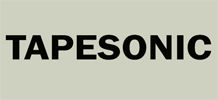
To 1957
Premier Electronics Labs Manufactured some really excellent tape recorders in New York City in the later 1950s – Early 1970s branded as Tapesonic.
Vernon

1899 To 1972
1899– Wollensak was founded Andrew Wollensak in St. Paul, Minnesota. Andrew Wollensak was first employed as a machinist by Bausch and Lomb in 1882, and helped Edward Bausch with the design of the Iris Diaphragm shutter 1950’s– The company was bought by the Revere Camera Company 1960– Wollensak was acquired by 3M, eventually becoming the Mincom Division 1964– Releases the T-1980 Sound Room model. It was larger but nearly identical to the T-1580 1967– The 5000 Series was developed for the consumer market. It was designed to be more competitive, and could hung on a wall or used on a Read More

